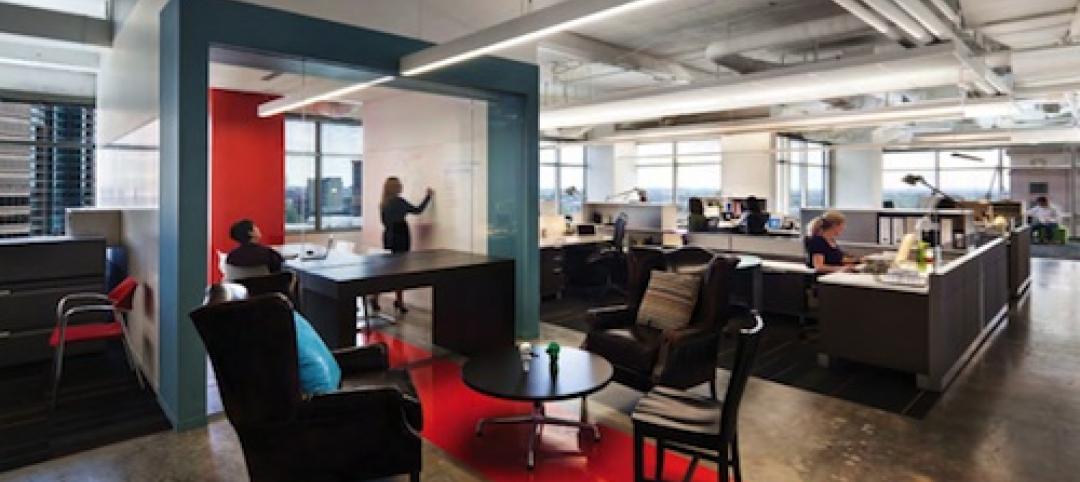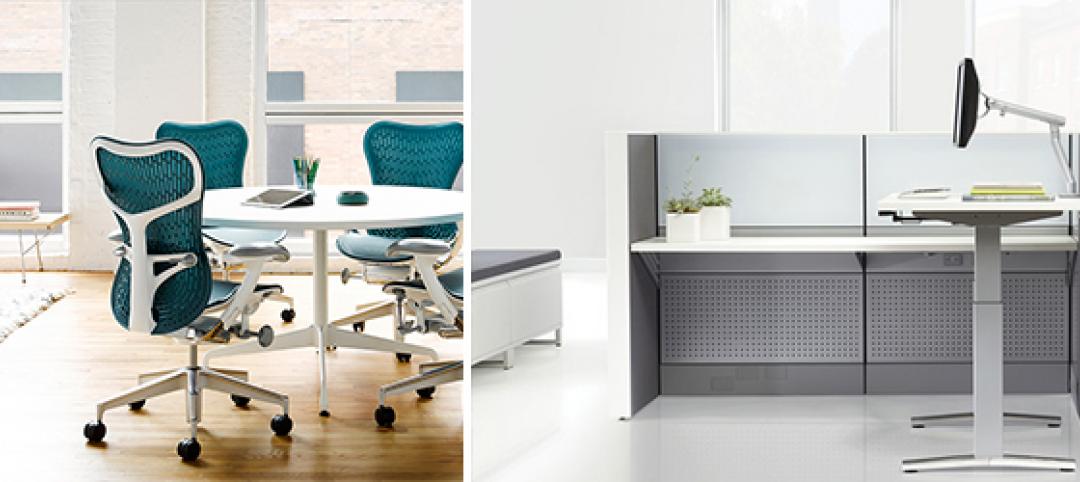Over the past decade, the average size of offices has shrunk by 30%, to 175 sf per employee. That trend coincides with the growing popularity of interior glass for offices construction and renovation.
“Glass is being used to reduce space but still give the appearance of openness,” says Brett Shwery, IIDA, CID, LEED AP BD+C, Senior Vice President–Corporate Workplace and Design and Delivery Director at AECOM’s Los Angeles office.
In 2016, Gensler completed an 800,000-sf government project with thousands of offices, all with glass fronts, says Maurice Reid, an Associate and Project Architect in the firm’s Washington, D.C., office. That project is also distinguished by stacked conference rooms on floors six through 13 that look onto the building’s 13-story atrium.
Demountable interior glass provides owners and property managers with the flexibility to reconfigure office spaces quickly to accommodate manpower or tenant shifts, says Bill Bouchey, IIDA, Director of Interiors with HOK, based in the firm’s New York office. Some glass systems allow information to be written or projected onto them, further enhancing workplace connectivity. And interior glass is more durable and requires less maintenance than drywall.
Interior glass has become the material of choice for office spaces because of “the extremely large floor plates” in North American projects that strive to get more natural light deep into the office core, observes Michael Banman, LEED AP BD+C, Principal and Architecture Discipline Lead in Stantec’s Winnipeg, Man., office. Banman and his colleague Todd Littlefield, an Interior Designer and Associate with the firm, note that LEED points are earned when offices afford employees greater visibility to the outdoors and exposure to daylight.
“We’re trying to be as sustainable as possible,” says Alan Gerencer, LEED AP, Principal and Architect with ZGF Architects, Portland, Ore., about what’s driving the greater use of glass in offices.
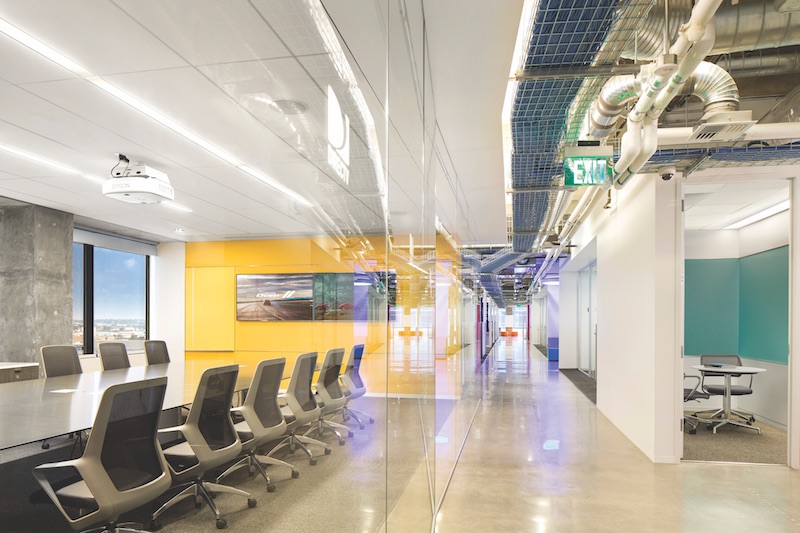 DirectTV’s 680,000-sf campus in El Segundo, Calif., is divided into four buildings and 37 floors. To create a high-energy work environment, AECOM interviewed 42 departments and 1,300-plus managers and employees about their work process. One of the key modifications was to replace high-paneled workstations and perimeter offices with open workstations along the windows with glass-faced offices at the core, and to increase the number of DirectTV’s collaborative spaces. The glass is also used to reinforce the company’s brand. The Building Team included AECOM (interior architect and workplace strategy), Nabih Youssef Associates (SE), ARC Engineering (MEP), Newsome Brown (acoustical engineer), and Clune Construction (GC). Photo: Rob Williamson/AECOM.
DirectTV’s 680,000-sf campus in El Segundo, Calif., is divided into four buildings and 37 floors. To create a high-energy work environment, AECOM interviewed 42 departments and 1,300-plus managers and employees about their work process. One of the key modifications was to replace high-paneled workstations and perimeter offices with open workstations along the windows with glass-faced offices at the core, and to increase the number of DirectTV’s collaborative spaces. The glass is also used to reinforce the company’s brand. The Building Team included AECOM (interior architect and workplace strategy), Nabih Youssef Associates (SE), ARC Engineering (MEP), Newsome Brown (acoustical engineer), and Clune Construction (GC). Photo: Rob Williamson/AECOM.
Minimizing sound bounce, leakage
Height generally isn’t an impediment when choosing interior glass for offices. Stantec has installed glass panels up to 15 feet tall, but thicker glass is needed for heights greater than nine feet.
Acoustical and privacy concerns also come into play when offices include an abundance of interior glass. For instance, when BD+C interviewed Banman and Littlefield from Stantec’s headquarters inside Winnipeg’s 13-story Centrepoint office tower, there was a perceptible echo over the phone. Banman and Littlefield suggested that this might have been the result of the glass-enclosed room they were in not being sufficiently outfitted with noise-absorbing materials, such as wall fabric, carpet tile, or area rugs.
“You need to pay attention to the surfaces, especially when the office design is ‘industrial,’” says Julie Farmer, Product Consultant with Modern Door, a glass installation subcontractor. She says Building Teams may also want to consider sound-masking technology to help with speech privacy and acoustics.
Margulies Perruzzi Architects “always” specifies half-inch glass “at a minimum,” and seals the joints to increase an office’s acoustical privacy, says Dianne Dunnell, IIDA, LEED AP, NCIDQ, the firm’s Interior Design Director.
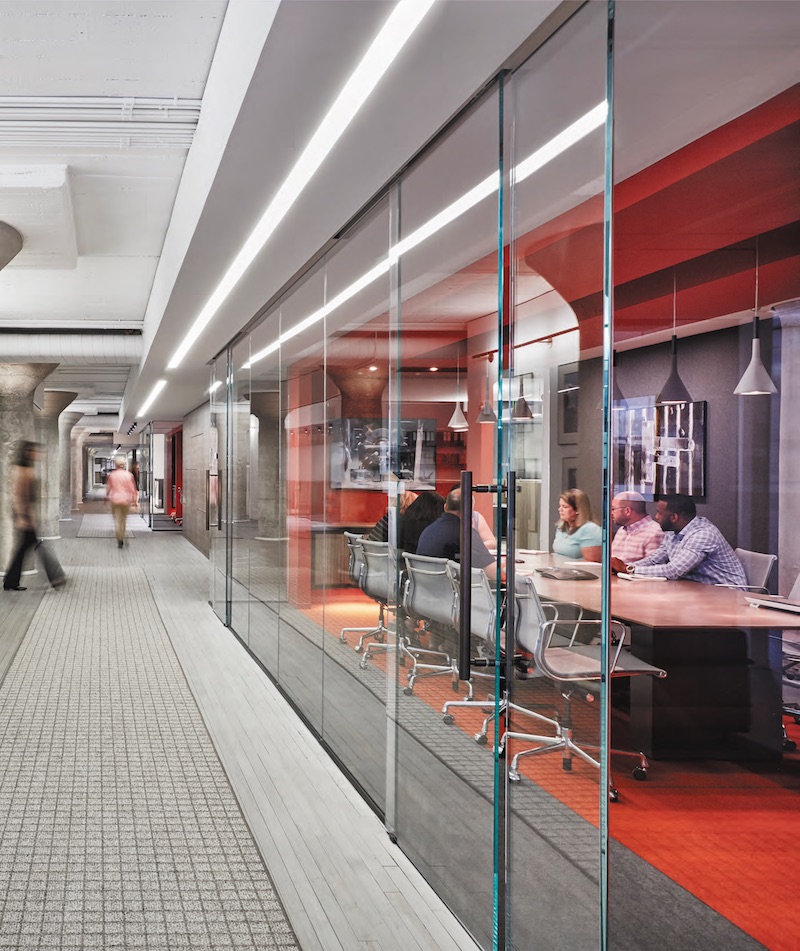 Jamestown, the real estate investment and development firm, transformed a former Sears building in Atlanta into the popular mixed-use Ponce City Market, which includes 64,000 sf of office space that comprises Jamestown’s headquarters. Within this space is a series of “workzones” (pictured), various-sized conference rooms strategically located off the main corridor that connects the large floorplate. Clean glass fronts reinforce the lux-loft feel and send a message of transparency. The Building Team included Gensler (architect and interior designer), Barrett Woodyard & Associates (MEP), and Humphries and Company (GC). Garrett Rowland/Courtesy of DORMA.
Jamestown, the real estate investment and development firm, transformed a former Sears building in Atlanta into the popular mixed-use Ponce City Market, which includes 64,000 sf of office space that comprises Jamestown’s headquarters. Within this space is a series of “workzones” (pictured), various-sized conference rooms strategically located off the main corridor that connects the large floorplate. Clean glass fronts reinforce the lux-loft feel and send a message of transparency. The Building Team included Gensler (architect and interior designer), Barrett Woodyard & Associates (MEP), and Humphries and Company (GC). Garrett Rowland/Courtesy of DORMA.
A new paradigm for privacy
Workplace privacy is definitely evolving. And the expanding use of interior glass is part and parcel of the move by companies to open up their workspaces to foment collaboration and camaraderie. Indeed, some companies are dispensing with offices altogether, preferring instead open and flexible floor plans, says Janel Fausti, IIDA, NCIDQ, Principal and Interior Designer at ZGF.
But most companies still need what one source calls “confidential sanctuaries” that offer greater privacy. And glass partitions and doors make some employees nervous because they feel like they’re in a fish bowl under the constant scrutiny of their bosses.
Privacy solutions often start—for owners, at least—with applying film over the glass, even though AEC firms aren’t keen on that option. Reid says Gensler advises its office clients to live with their spaces for a few months before making privacy-related changes, which ultimately might only mean moving workstations around. MPA makes the same recommendation. “In most cases, they don’t install film at all,” says Dunnell.
Several AEC sources, though, are intrigued about “cloaking” film, a new product from Designtex that, in essence, jumbles content: a person looking into a glass-enclosed room covered with cloaking film can see people but not information, such as numbers on computer screens or a projected slideshow presentation.
Costlier options include opaque laminated glass and so-called “switchable” glass, which electronically darkens the panes. “Switchable glass is good for giving conference rooms a ‘wow’ factor and privacy on demand,” says Dunnell. She notes, though, that it is “never really clear.”
Translucent glass is available in a variety of prints, patterns, and colors. And some companies are using this glass for branding purposes.
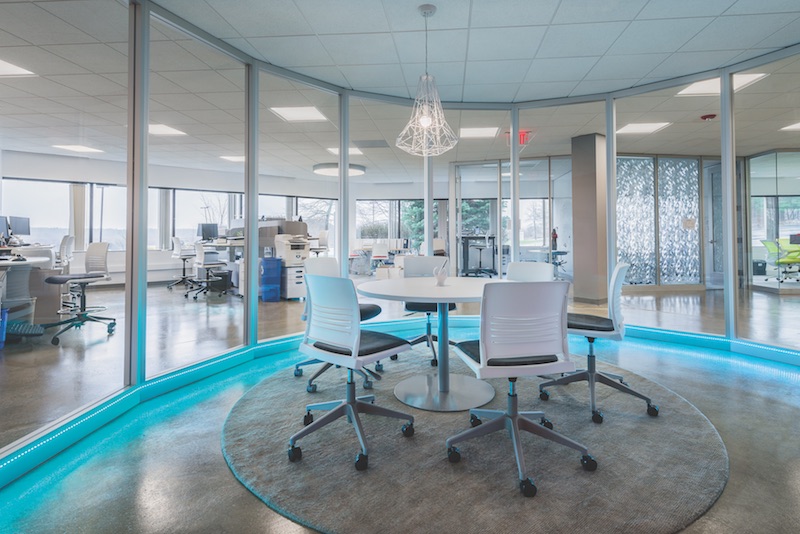 A central conference room illuminated with blue LED accent lighting is a core element of the new 21,000-sf corporate headquarters for business services firm The Predictive Index. The fit-out project used extensive interior glass walls and doors to create an open, flexible workspace within the 101 Station Drive building in Westwood, Mass. On the Building Team: National Development (developer), Margulies Perruzzi Architects (interior architect), Little Dragon Decor (interior designer), AHA Consulting Engineers (MEP), STV|DPM (owner’s project manager), and Commodore Builders (GC). Photo: Sabine Mueller Creative.
A central conference room illuminated with blue LED accent lighting is a core element of the new 21,000-sf corporate headquarters for business services firm The Predictive Index. The fit-out project used extensive interior glass walls and doors to create an open, flexible workspace within the 101 Station Drive building in Westwood, Mass. On the Building Team: National Development (developer), Margulies Perruzzi Architects (interior architect), Little Dragon Decor (interior designer), AHA Consulting Engineers (MEP), STV|DPM (owner’s project manager), and Commodore Builders (GC). Photo: Sabine Mueller Creative.
How much light is right?
Glare doesn’t seem to be a major issue when installing interior glass. Still, AEC firms say that more glass in office buildings needs to account for natural light coming into the space, as well as the office’s lighting design.
“They need to work in tandem,” says AECOM’s Shwery. Gensler uses artificial light to minimize the low and high light contrasts caused by daylight streaming into an office, says Reid. At its headquarters, Stantec installed perforated roller blinds on exterior windows and automated interior lighting controls, says Banman.
In some cases, glare must be addressed more directly. HOK recently worked on a 600,000-sf building in Manhattan whose south and west sides were exposed to significant sunlight during afternoon hours. Bouchey says his firm only realized how serious this problem could be when it built a 3,000-sf mockup of one of the offices.
HOK’s solution was to: eliminate all conference rooms along the perimeter of the building; install a shading system on the perimeter windows; apply four-foot-high film strips on the glass for interior rooms to cool “hot spots”; and move the interior lighting in the ceiling 12 inches farther away from the interior glass walls.
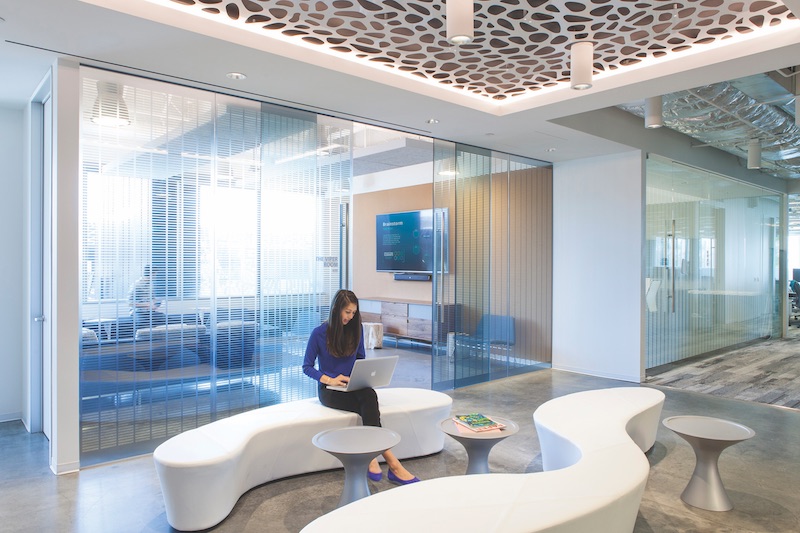 Mindshare’s 41,500-sf office, on 2½ floors in a building in Playa Vista, Calif., is a shared workspace for eight creative firms. Organized as a series of “neighborhoods,” the office employs an abundance of interior glass as part of a 100%-open environment. It features client and employee “public zones” such as this lounge (pictured), supported by collaborative spaces that express each firm’s personality. The Building Team included HOK (interior architect), ARC Engineering (engineer), TSP (project management), and Clune Construction (GC). Photo: Kim Rodgers.
Mindshare’s 41,500-sf office, on 2½ floors in a building in Playa Vista, Calif., is a shared workspace for eight creative firms. Organized as a series of “neighborhoods,” the office employs an abundance of interior glass as part of a 100%-open environment. It features client and employee “public zones” such as this lounge (pictured), supported by collaborative spaces that express each firm’s personality. The Building Team included HOK (interior architect), ARC Engineering (engineer), TSP (project management), and Clune Construction (GC). Photo: Kim Rodgers.
Frameless glass looks great, but…
Modern Door recently completed the renovation of six Capitol One offices, all with frameless glass for conference and meeting rooms. “We’re seeing a lot more frameless applications with polycarbonate seals,” says Farmer.
Frameless “looks cleaner,” says Gensler’s Reid, and eliminates the need for opaque pieces to create a seamless wall. Virtually every manufacturer has an office-front system that includes frameless glass, says Bouchey.
But frameless glass has some limitations. Dunnell notes that any interior office structure that includes an opening of four to six feet “would need to be framed.” Framed systems provide much better acoustical privacy, according to experts who spoke with BD+C. And framed systems are easier to install than frameless if floors and ceilings are uneven, says Reid.
Frameless glass can also pose safety and liability problems because “people are going to walk into frameless walls and doors,” says Gerencer. “We wouldn’t install frameless in high-traffic areas.”
Fausti says the frameless/framed debate often comes down to what statement a company wants to make, and how much it’s willing to spend.
ZGF recently completed an office project for a law firm, Stoel Rives, which wanted timber trim framing around glass walls and doors to complement the office’s wood floors, walls, and ceilings.
On the other hand, ZGF converted an old warehouse in Portland, Ore., to office space for the children’s clothes retailer Hanna Andersson, which required floor-to-ceiling frameless glass partitions and sliding doors. ZGF saved money by lowering the top of the glass panel by about an inch from the ceiling, and capping the top and bottom of the glass with steel framing.
Related Stories
| Aug 13, 2013
DPR's Phoenix office, designed by SmithGroupJJR, affirmed as world's largest ILFI-certified net-zero facility
The new Phoenix Regional Office of DPR Construction, designed by SmithGroupJJR, has been officially certified as a Net Zero Energy Building by the International Living Future Institute (ILFI). It’s the largest building in the world to achieve Net Zero Energy Building Certification through the Institute to date.
| Aug 8, 2013
Stanley Hardware introduces Flexi-Felt for protecting floors
Stanley Hardware offers a solution to the frustrating problem of protecting your floors. The answer is Flexi-Felt®, an innovative product line that eliminates the aggravation of frequently replacing felt pads and leg tips that usually wear down or fall off, causing damage to expensive floors.
| Aug 8, 2013
New green property index could boost REIT investment in more sustainable properties
A project by the National Association of Real Estate Investment Trusts (NAREIT), the FTSE Group, and the U.S. Green Building Council to jointly develop a Green Property Index could help REITs attract some of the growing pool of socially responsible investment money slated for green investments.
| Aug 6, 2013
CoreNet: Office space per worker shrinks to 150 sf
The average amount of space per office worker globally has dropped to 150 square feet or less, from 225 square feet in 2010, according to a recent global survey conducted by CoreNet Global.
| Aug 6, 2013
Australia’s first net zero office building features distinctive pixelated façade
Australia's first carbon neutral office building, featuring a distinctive pixelated façade, recently opened in Melbourne.
| Jul 30, 2013
In support of workplace chatter
As the designers of collaborative work environments, architects and engineers understand how open, transparent spaces can cultivate the casual interaction and knowledge sharing that sparks innovation. Now a new study reveals another potential benefit of open workplaces: social interaction that supports happier employees.
| Jul 29, 2013
2013 Giants 300 Report
The editors of Building Design+Construction magazine present the findings of the annual Giants 300 Report, which ranks the leading firms in the AEC industry.
| Jul 25, 2013
3 office design strategies for creating happy, productive workers
Office spaces that promote focus, balance, and choice are the ones that will improve employee experience, enhance performance, and drive innovation, according to Gensler's 2013 U.S. Workplace Survey.
| Jul 25, 2013
How can I help you?: The evolution of call center design
Call centers typically bring to mind an image of crowded rows of stressed-out employees who are usually receiving calls from people with a problem or placing calls to people that aren’t thrilled to hear from them. But the nature of the business is changing; telemarketing isn’t what it used to be.
| Jul 23, 2013
Tell us how you're reimagining the medical office building
"Obamacare" implementation will add thousands of people to the ranks of the insured, including many who formerly sought primary care in emergency rooms. Now, these patients will have coverage that allows them to more easily access the typical treatment channels—and that means greater demand for services provided in medical office buildings.









